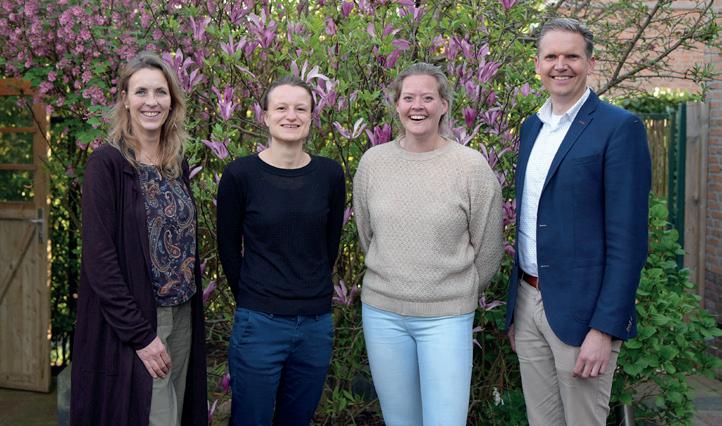Monitoring animal health – small ruminants, 2024
Disease/disorder/ health characteristic
Brief description
Articles 2.1.a and 2.1.b of the Designation of Animal Diseases in the Rules for Animal Health/Implementing Regulation (EU) 2018/1882 of the Animal Health Law (EU) 2016/429 (Category A diseases)
Infectious pleuropneumonia in goats (CCPP)
(Mycoplasma capricolum subs. capripneumoniae)
Never detected in the Netherlands.
Foot-and-mouth disease (FMD) Not reported in the Netherlands since 2001.
Infection with goat plague (a.k.a. PPR, peste des petits ruminants)
Infection with Rift Valley Fever virus (RVF)
Never detected in the Netherlands.
Never detected in the Netherlands.
Sheep pox and goat pox (SGP) Never detected in the Netherlands. Multiple outbreaks detected at sheep farms in Spain from September 2022 to the spring of 2023. The calculated risk of SGP being introduced into the Netherlands is deemed small. From October 2023 onwards, multiple outbreaks have been confirmed in Greece.
Articles 2.1.a and 2.1.b of the Designation of Animal Diseases in the Rules for Animal Health/Implementing Regulation (EU) 2018/1882 of the Animal Health Law (EU) 2016/429 (Categories B to E)
Infection with Brucella abortus, B. melitensis
Infection with the rabies virus
Infection with the bluetongue virus (serogroups 1-24)
The status of the Netherlands is ‘disease-free’. Monitoring is done annually on sheep and goat farms (a minimum of 1,475 farms) by taking blood samples.
Detected very rarely in bats.
An outbreak of BTV-3 has been ongoing since September 2023. The impact of the outbreak on the affected farms is considerable, leading to excess deaths of over 55 thousand sheep. Clinical cases of BTV-3 have been reported in Belgium and Germany. Passive monitoring in the UK has detected BTV-3.
Overwintering of BTV-3 is seen as a realistic possibility. Several BTV-3 vaccines have been available since early May 2024.
There is an outbreak of BTV-8 in France leading to more clinical complaints than the outbreak that has been ongoing since 2015. The two BTV-8 serogroups detected are genetically different.
Active monitoring in Spain has shown that BTV-4 is circulating. Mandatory vaccination is in place, aiming to restrict the outbreak.
B+D+E *
B+D+E
C+D+E *
Epididymitis in sheep (Brucella ovis)
Examination of rams for export purposes. Not previously confirmed in NL.
Disease/disorder/ health characteristic
Infection with Mycobacterium tuberculosis complex
(M. bovis, M. caprae, M. tuberculosis)
Anthrax (Bacillus anthracis)
Paratuberculosis (Mycobacterium avium subs. paratuberculosis)
Q fever (Coxiella burnetii )
Brief description
The Netherlands has been officially free of bovine tuberculosis since 1999.
Last registered outbreak in cattle in 1993. No infections detected since then.
Regular cases, largely in goats (inc. dairy) and occasionally in sheep.
Q fever was detected in April in a bulk milk sample from a dairy sheep farm. The animals concerned were pregnant yearlings that had not been vaccinated against Q fever despite it being mandatory. The final dairy goat farm with C. burnetii was certified free from infection in 2016.
Echinococcosis An echinococcus cyst was detected during pathological examination of a sheep in April 2023. The specific type is not known.
Trichinellosis No known cases of trichinellosis in sheep or goats.
Article 2.1.c Designation of animal diseases in the Rules for Animal Health of the Dutch Animals Act
Transferable TSEs (scrapie, BSE) No cases have been seen in sheep in the last ten years. In goats, the first case of scrapie was in 2000 and the last in 2001.
Article 3a.1 Notification of zoonoses under the Rules for Animal Husbandry of the Dutch Animals Act Campylobacteriosis (Campylobacter spp.)
Leptospirosis (Leptospia Hardjo)
Listeriosis (Listeria spp.)
A few cases per year. Particularly known as a cause of abortion in small ruminants.
Not previously confirmed in NL. In February 2024, strong indications of Leptospira spp. were found in the liver tissues of aborted lambs. The serogroup involved is not known.
Encephalitis caused by Listeria monocytogenes is regularly found in sheep and especially in dairy goats. Problems caused by listeriosis are reported at a few dairy goat farms each year. How long listeria bacteria are secreted into the milk for is not known.
Both L. monocytogenes and L. ivanovii can cause abortion in sheep and goats.
*Further investigation into the types found in humans and animals would be desirable.
Disease/disorder/ health characteristic
Salmonellosis (Salmonella spp.)
Yersiniosis (Yersinia spp.)
Toxoplasmosis (Toxoplasma gondii )
Other OIE list diseases
Enzootic abortion (Chlamydia abortus)
Caprine arthritis encephalitis (CAE)
Maedi-visna virus (MVV)
Tularaemia (Francisella tularensis)
Mycoplasma agalactiae
Nairobi sheep disease
Heartwater (Ehrlichia ruminantium)
Infections with Schmallenberg virus (SBV)
Brief description
Since 2016, there have been recurrent and large-scale losses of kids at dairy goat farms, caused by a multiresistant S. Typhimurium. There also were multiple cases of illness in humans caused by the same MLVA strain of the bacterium.
In March 2024, salmonellosis was detected at two dairy goat farms. These were infections with Salmonella spp. from groups B and D. Effects such as abortions, severe diarrhoea and elevated mortality rates were observed.
A few cases per year. Identified as a cause of diarrhoea, mortality and abortion.
Only a few confirmed cases per year but probably one of the most commonly occurring causes of abortion. High seroprevalence has previously been demonstrated in sheep and goats.
One of the main causes of abortion in goats and sheep for many years. Distribution from farm to farm is through contaminated female breeding stock. Very difficult to tackle once introduced to a flock.
Commonly occurring disease in which the pathogenic virus sometimes behaves differently depending on the size of the farm. Source of introduction not always clear.
A significant infectious disease (or the most significant) at sheep farms, larger ones in particular.
Since 2011, infected hares have regularly been found in the Netherlands, as well as a small number of human tularaemia patients.
Never detected in the Netherlands.
Never detected in the Netherlands.
Never detected in the Netherlands.
Has been detected virtually every year since 2011 as a cause of congenital abnormalities in lambs. It has been detected as the cause of malformations in both lambs and kids in 2024. Excluding other possible causes of such congenital abnormalities in lambs remains important for early detection of the introduction of other viruses from the Bunyaviridae group, which can lead to the same external clinical deformations. The UK reported elevated incidences of SBV early in 2024.
further study of dairy goats is underway within the framework of public-private partnership, looking at increased sustainability of dairy goat farming.
Disease/disorder/ health characteristic
From monitoring
Abortion in small ruminants
Chronic liver fluke disease
Dermatitis caused by Staphylococcus aureus
Disbudding kids
Osteogenesis imperfecta
Brief description
During the early months of 2024, various infectious agents were detected that cause abortions in sheep and goats. Many causes of abortions are also zoonoses. The number of submissions remains low.
In the spring of 2024, several cases of chronic liver fluke disease were seen in sheep. Tracking down infections (including chronic ones) and treating them is important for combating this disease.
Dermatitis of the skin of the udder is regularly detected on dairy goat farms. S aureus can be transmitted between animals and humans
Multiple submissions of kids showing signs of meningitis after being disbudded.
Pathological examinations have found indications of osteogenesis imperfecta among Barbados Blackbelly lambs a few months old. It is thought likely that there is a genetic component to this.
1 Quiet: no action required or action is not expected to result in a clear improvement.
2 Increased attention: alert to an anomaly.
3 Further investigation: further investigation is ongoing or required.
Continuation
Animal health monitoring
Royal GD has been responsible for animal health monitoring in the Netherlands since 2002, in close collaboration with the veterinary sectors, the business community, the Ministry of Agriculture, Fisheries, Food Security and Nature, veterinarians and farmers. The information used for the surveillance programme is gathered in various ways, whereby the initiative comes in part from vets and farmers, and partly from Royal GD. This information is fully interpreted to achieve the objectives of the surveillance programme – rapid identification of health issues on the one hand and monitoring trends and developments on the other. Together, we team up for animal health, in the interests of animals, their owners and society at large.












